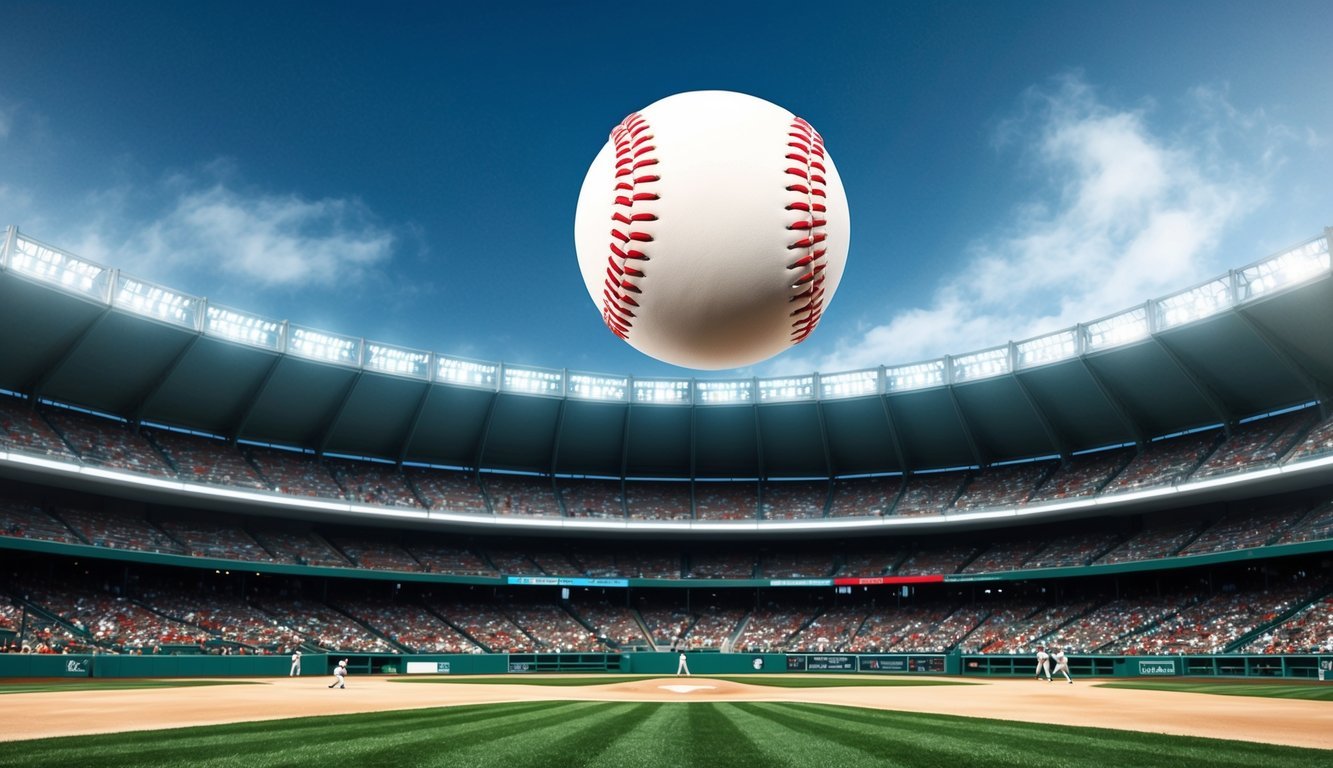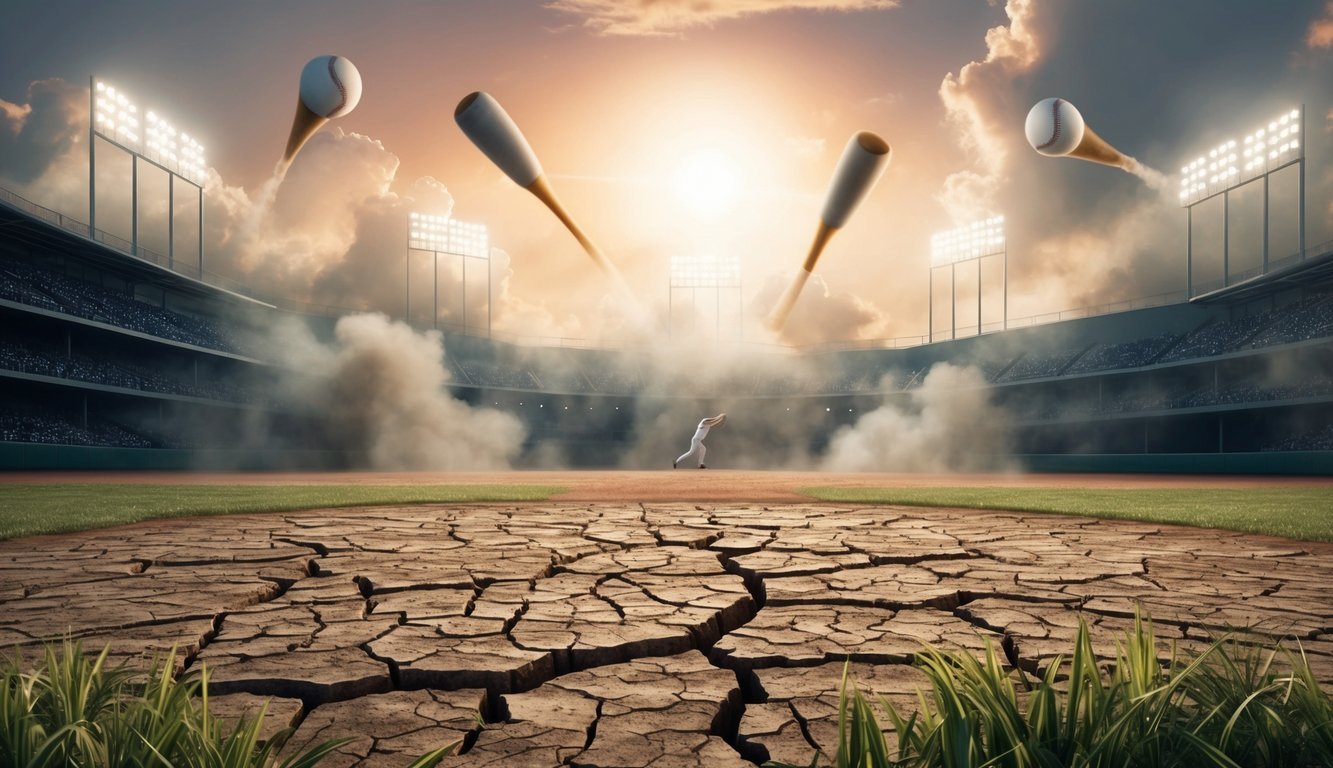Baseball fans have witnessed a surge in home runs in recent years, with balls flying out of stadiums at an unprecedented rate.
This power-hitting phenomenon has captivated audiences and sparked debates among players, analysts, and scientists alike.
Some studies suggest that climate change may be contributing to the rise in home runs.
Warmer temperatures create thinner air that allows baseballs to travel farther.
The increased focus on launch angles and exit velocities has also played a role in the home run boom.
Hitters are now actively trying to elevate the ball, aiming for those crowd-pleasing long balls.
This shift in approach has led to more exciting games but has also resulted in a higher number of strikeouts as batters swing for the fences.
Major League Baseball has conducted independent studies to understand the factors behind the home run surge.
Microscopic variations in ball construction, particularly seam height, have been identified as potential contributors.
As the debate continues, fans can expect to see more thrilling displays of power at the plate in the coming seasons.
Historical Trends in Home Runs
Home runs have shaped baseball’s history, with dramatic shifts in frequency and impact over different eras.
The long ball has transformed from a rarity to a game-defining element, influenced by various factors.
Era Comparisons and Record Breakers
In the late 19th century, home runs were infrequent.
The 1906 season saw only 261 homers across the league.
This changed dramatically in the 1920s with Babe Ruth’s arrival.
Ruth revolutionized the game, making home runs a central part of a player’s offensive arsenal.
The 1950s and 60s brought new slugging icons.
Mickey Mantle and Willie Mays thrilled fans with their power hitting.
Home run totals steadily climbed, reflecting changes in player approach and ballpark design.
Recent years have seen unprecedented power numbers.
In 2017, MLB players hit a record 6,105 home runs.
Aaron Judge’s 62 homers in 2022 set a new American League single-season record.
This power surge has fueled ongoing debates about changes in hitting approaches, ball composition, and player conditioning.
As players continue to refine their swings, the best baseball bats 2024 models are designed with advanced materials and optimized barrel performance to maximize power.
With technology constantly evolving, the next generation of sluggers may push home run records even higher.
Impact of Player Training and Physical Health
Modern training methods have significantly boosted home run production.
Players now focus on strength training and launch angle to maximize power.
This has led to more hitters adopting an all-or-nothing approach at the plate.
Improved nutrition and medical care have helped players maintain peak performance.
However, this era has also seen concerns about steroid abuse.
The “Steroid Era” of the late 1990s and early 2000s saw inflated home run totals, raising questions about the legitimacy of some records.
MLB has since implemented stricter testing policies.
This has helped restore faith in the game’s integrity while still allowing for impressive power displays from clean players.
Physics and Environmental Factors in Baseball
The science behind baseball’s home run surge involves complex interactions between physics principles and environmental conditions.
These factors significantly influence ball flight and game outcomes.
The Science of Ball Trajectory
Launch angle and exit velocity play crucial roles in determining a baseball’s path.
Higher launch angles combined with greater exit speeds increase the likelihood of home runs.
Modern players have adapted their swings to optimize these factors.
Ball construction also impacts flight characteristics.
Seam height and core composition affect air resistance and the ball’s “bounciness” off the bat.
MLB has faced scrutiny over alleged changes to ball manufacturing that may have contributed to increased home run rates.
Physics principles like Magnus force and drag coefficient further shape a ball’s trajectory.
The Magnus force, created by the ball’s spin, can cause it to curve or drop.
Drag affects how quickly the ball loses speed as it travels through the air.
Air Density and Game Day Weather
Temperature, humidity, and air pressure all affect a baseball’s flight path.
Warmer air is less dense, allowing the ball to travel farther.
This phenomenon may partially explain higher home run rates in summer months and day games.
Climate change has become a factor in baseball’s power surge.
Rising temperatures have led to an estimated 1% increase in home runs, or about 50 additional homers per year across MLB.
Wind patterns at different stadiums can dramatically influence ball carry.
Some ballparks are known for their wind effects, either aiding or hindering long balls depending on direction and strength.
Altitude also plays a role.
In higher elevation parks like Coors Field in Denver, the thinner air reduces drag on the baseball, leading to more home runs.
Technology and Analytics in Baseball

Baseball has embraced cutting-edge technology and data analysis to gain deeper insights into player performance and game dynamics.
These advancements have revolutionized how teams evaluate talent and strategize on the field.
Advancements in High-Speed Cameras
High-speed cameras have transformed how baseball analyzes player mechanics and ball movement.
These cameras capture thousands of frames per second, allowing teams to study minute details of pitches, swings, and fielding movements.
Coaches use this footage to fine-tune batting stances and pitching deliveries.
Players can see exactly how the ball spins off their fingertips or how their bat contacts the ball.
This visual feedback helps them make micro-adjustments to improve their technique.
In ballparks, strategically placed cameras track the entire flight path of batted balls.
This data helps teams position fielders more effectively based on each batter’s tendencies.
Statcast and Game Analytics
Statcast has revolutionized how fans and teams alike understand the game.
This system uses radar and cameras to measure previously unquantifiable aspects of player performance.
Launch angle and exit velocity are now common terms, describing how batters impact the ball.
Pitchers are evaluated on spin rate and movement profiles.
Even fielders’ routes and reaction times are precisely measured.
Teams employ data scientists to sift through this wealth of information.
They identify patterns and tendencies that inform in-game decisions and long-term player development strategies.
This data-driven approach has led to changes in hitting philosophy.
Many batters now aim for optimal launch angles to increase their chances of hitting home runs.
Stadiums and Playing Conditions

Stadium design and environmental factors significantly impact home run rates in baseball.
These elements create unique playing conditions that can favor or hinder power hitting.
Effects of Different Stadium Designs
Ballpark dimensions vary widely across Major League Baseball, influencing home run potential.
Some stadiums have shorter fences, making it easier for batters to hit homers.
For example, Yankee Stadium’s right field is notoriously short at 314 feet.
Domed stadiums like Tropicana Field eliminate wind and weather variables, providing consistent conditions for hitters.
This can lead to more predictable ball flight paths.
Open-air parks like Wrigley Field are subject to wind patterns that can either carry balls out or knock them down.
These changing conditions add an extra challenge for batters and pitchers alike.
Role of Elevation and Climate in Ballparks
Coors Field in Denver, situated at a high elevation, is known for its homer-friendly environment.
The thin air allows baseballs to travel farther, boosting home run numbers.
Climate plays a crucial role in outdoor stadiums.
Warmer temperatures can increase ball flight distance.
A study found that climate change may be contributing to the recent surge in home runs.
Humidity levels affect ball grip and aerodynamics.
Low humidity in arid climates can make the baseball slicker, potentially leading to more home runs.
Wind patterns in coastal ballparks can dramatically impact fly balls, either helping them over the fence or pushing them back into play.
Climate Change and Its Impact on Baseball

Rising temperatures and atmospheric changes due to global warming are affecting America’s favorite pastime in unexpected ways.
The connection between climate change and baseball performance has become a subject of scientific inquiry.
Global Warming and Rising Temperatures
Climate scientists have observed a steady increase in global temperatures over recent decades.
This warming trend is impacting various aspects of daily life, including sports.
In baseball, warmer air is less dense, allowing baseballs to travel farther when hit.
Denver’s Coors Field, known for its high elevation, has long experienced this effect.
Now, as temperatures rise across the country, other ballparks are seeing similar results.
Players and fans alike have noticed an uptick in home runs, especially on particularly warm days.
Research Linking Climate Change to Home Runs
A study published in the Bulletin of the American Meteorological Society examined the relationship between climate change and home run rates.
Researchers Christopher Callahan and Justin Mankin analyzed temperature data and baseball statistics from 2010 to 2019.
Their findings were striking: climate change could be attributed to over 500 home runs during this period.
This represents about 1% of all home runs hit.
The study used climate models to isolate the impact of human-caused global warming on game-day temperatures.
Physics professor Alan Nathan explained that a well-hit ball travels about 0.75 meters farther for every 1°C increase in temperature.
This small difference can turn warning-track fly balls into home runs.
